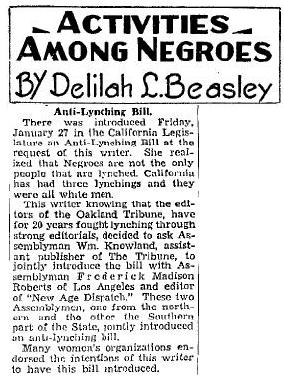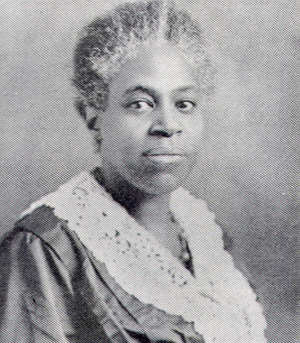
Happy Friday POU!

Delilah Leontium Beasley (September 9, 1867 – August 18, 1934), was an American historian, and newspaper columnist for the Oakland Tribune, Oakland, California, US. Beasley becomes the first African-American woman to be published regularly in a major metropolitan newspaper.
As a writer, Beasley has the distinction of being the first person to have presented written proof of the existence of California black pioneers, in her writings, Slavery in California (1918) and her classic, The Negro Trail-Blazers of California (1919), a pioneering work in the field of California black history. Her journalists career spanned over fifty years, including detailing the racial problems in California and the heroic achievements by Blacks to overcome them, during the late 19th century and early 20th century.
Beasley was born in Cincinnati, Ohio, the oldest of five children in the family of Daniel Beasley, an engineer, and Margaret Harris, a homemaker. After her parents’ death while she was still a teenager, Beasley had to find a full-time job to support herself, she pursued a career as a trained masseuse. She began her newspaper career in 1883 writing for a black newspaper the Cleveland Gazette, founded by Harry C. Smith. She wrote briefly about church and social activities. Three years later, she published her first column in the Sunday Cincinnati, Ohio, Enquirer under the headline “Mosaics”. Beasley studied journalism under Dan Rudd, a well-known newspaper publisher of the Colored Catholic Tribune in Cincinnati.
In 1910, at age 39, Beasley moved to Oakland, California, attending lectures and researching at University of California, Berkeley and writing essays for presentations at local churches. In 1910 the African American population in Oakland was 3,055. The small black population supported a flowering of indigenous institutions and community formation in the 10s and 20s. Among these institutions were various black-owned small businesses, churches, and private social-welfare organizations. In addition, several black newspapers were published in Oakland, including the Oakland Sunshine, which began publication in 1902, publisher William Prince, and the Western Outlook, established in 1894, publishers J. S. Francis and J. L. Derrick. In 1915, she wrote for a black audience in the Oakland Sunshine.
Trail-Blazers Book
Delilah Beasley chronicled African American “firsts”, and notable achievements in early California in her book The Negro Trail-Blazers of California (1919). A compilation of records from the California Archives in the Bancroft Library at the University of California, Berkeley, searching newspapers from 1848 to the 1890s, all the black newspapers from the first in 1855 through 1919. Beasley Trail-Blazers book included diaries, biographical sketches, poetry commemorating black sacrifices, photographs, old papers, conversations of old pioneers, a comprehensive history of early legislation and court cases. Beasley’s informative compilation of records is full of success stories. It gives many hundreds of names of blacks in California from the pioneer period to the late 19th century.
Beasley writes about the black gold miners of the late 1840s:
- “A history of the Negro people of California would be incomplete without mention of the mining men who came in 1849. There were at one time several hundred Negro miners working claims on Mormon and Mokelumn Hill, at Placerville, Grass Valley and elsewhere in California mountains. One such man was Moses Rodgers a mining expert and was considered one of the best mining engineers in the state. He was also a metallurgist and owned a group of mines at Hornitus. The colored miners rarely took a chance in buying mining stock. He had more sacred duties to perform with his money. He either used it to pay for the freedom or liberty of himself, his family or other loved ones in faraway “Dixie-Land“. If not that, then he contributed largely from his diggings to assisting the “Executive Committee of the Colored Convention” in their struggles to secure legislative enactments in the interest of the Negro race in California”.
Beasley spent nine years writing her book, the book is important to historians of California and the West, and of African American western history. She knew many people who had been in California from the beginning of statehood and before. So much of what we know of California black pioneers grows out of her book. One of her possible heroes in the book was Lt. Col. Allen Allensworth, in 1908 founder of an all African American town in Allensworth, California, now a state park, Colonel Allensworth State Historic Park. Beasley wrote, “The late Colonel Allensworth was born a slave, and yet there are few, if any, who have made more out of life and done more for their fellow man”.
Newspaper Columnist

Her work on the book The Negro Trail-Blazers paved the way for Beasley to become the first Black woman in California to write regularly for a major metropolitan newspaper. By 1925 Delilah was writing regularly for the Oakland Tribune. Her Sunday Tribune column was Activities Among Negroes and her name was also published with the articles. She often spent far over forty hours a week collecting material for her column. She wrote about churches, social events, women’s clubs, literary societies, and local as well as national politics. Beasley’s motivation was to give the white readers of the Oakland Tribune a positive picture of the black community. She documented the achievements of successful black men and women, in Oakland and elsewhere. By highlighting such items, she served her larger goal of demonstrating the capabilities of African-Americans while building a strong constituency for her column and a network of sources from whom she could count on receiving information. There is no doubt that in performing this service she laid an important part of the groundwork for the expanded inter-racial cooperation that developed during the Depression era of the 1930s. Richard Dillon, whose book on California Pioneers who had special qualities of their unusual and stimulating lives, wrote that Beasley was “born 50 years before her time”. Beasley wrote for the Oakland Tribune from 1925–1934.
Community Service And Social Activism
In 1929, Beasley also used her professional skills and prominence in international groups to rebut white fears about the consequences of creating an International House at the University of California, Berkeley. Many Berkeley landlords protested the construction of the House, fearing an influx of foreigners. International House at UC Berkeley is a multi-cultural residence and program center serving students, the local community and alumni worldwide. Its mission is to foster intercultural respect, understanding, lifelong friendships and leadership skills for the promotion of a more tolerant and peaceful world. The university wrote: “More than 800 people gathered in Berkeley to protest racial integration in the proposed International House. At that meeting, Delilah Beasley, a black reporter for the Oakland Tribune, passionately defended the concept to a disgruntled and stunned audience. And it was Beasley who stood up to the protests of property owners who feared that I-House would cause Berkeley to be overrun with Blacks and Asians”. Notable I-House alumni and residents are, Delbert E. Wong, Jerry Brown, Oona King, Chitra Banerjee Divakaruni, Rose Bird, F. Drew Gaffney, Eric E. Schmidt, and Sadako Ogata.
The weekly column she wrote for the newspaper, Activities Among Negroes, enhanced her standing in the community because of her ability to generate favorable publicity for black political struggles. Recognition of her ability to influence the white community strengthened her status within both white and black communities. She confronted misconceptions and contradictions as a newspaper journalist, and campaign against the use in the press of explicitly derogatory words when writing about African Americans. In 1932, Beasley organized the donation of a painting by a Black artist to the Oakland Museum. Due to her efforts as president of the “Far Western Inter-Racial Committee,” a painting by Eugene Burk, titled “The Slave Mother” was unveiled and presented to gallery director William Clapp, with Beasley expressing hope that “the presentation of this picture to the permanent collection of the Oakland Municipal Art may be the means of opening many doors to young aspiring Negroes, not only of Oakland but of the United States.” Clapp responded,
- “We feel a very great appreciation of the thought and effort. Even under normal conditions the gift would be remarkable, since it is the first presented in this gallery as a formal expression of racial culture. It is also noteworthy because it is the first work of art that has been presented to the gallery by an organized group of citizens”.
In 1933, it was at Beasley’s urging that California State Assemblyman William F. Knowland, then assistant publisher of the Oakland Tribune, and AssemblymanFrederick M. Roberts of Los Angeles County, introduced an anti-lynching bill, that passed unanimously in both branches of the California Legislature.[28][29] It was the state’s first mob violence law. The majority of lynching in California between 1850 and 1935 were perpetrated against Latinos, Native Americans, and Asian Americans.

Today, veteran and student journalists are honored with the Hall of Fame & Scholarship Awards of the Cincinnati chapter of the National Association of Black Journalists, with the “Delilah Leontium Beasley Scholar” awards.
